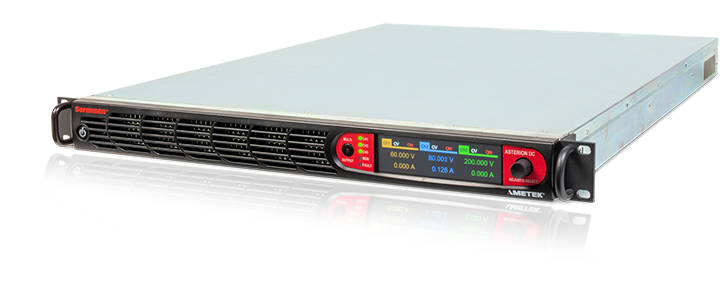Purchasing Criteria for Programmable DC Supplies Evolve as Performance and Features Advance
Purchasing Criteria for Programmable DC Supplies Evolve as Performance and Features Advance
DC power supplies have significantly improved over the past decade. Modern supplies offer higher power densities, helping you save rack space. In addition, modern supplies can provide considerable flexibility in power, current, and voltage ratings, helping you future-proof your test systems to meet changing requirements.
Programmable DC supplies have the capacity to boost power density
The AMETEK Sorensen Asterion DC ASM Series packs 5,100 W into a 1U chassis (Figure 1), which is a great example of the high-power density now available. Offering three independent, isolated 1,700-W channels, the Asterion DC ASM replaces legacy systems that previously required three separate 1U chassis. These products are designed for telecommunications, commercial, military, aerospace, semiconductor, and automotive applications requiring low profile, light-weight power supplies, and it offers nine different fixed-range output-voltage options that extend from 40 to 600 V.
Figure 1. The Asterion DC ASM Series offers three 1,700-W channels in a 1U chassis.
Future-proof your systems
To achieve optimal flexibility in output voltage and current ratings, you can choose the Asterion DC ASA Series three-channel supplies. Each channel delivers a 600-W autoranging output in which maximum output voltage varies inversely with maximum output current (Figure 2). Available output configurations provide five constant-power output ratings:
- 60 V at 10 A to 14.2 V at 42A
- 80 V at 7.5 A to 27.2 V at 22 A
- 200 V at 3 A to 35.2 V at 17 A
- 400 V at 1.5 A to 100 V to 6 A
- 600 V at 1 A to 214.2 V at 2.8 A.
Figure 2. The Asterion AC ASA Series offers five 600-W autoranging output configurations extending from 14.2 V at 42 A to 600 V at 1 A.
In addition to the ASA and ASM series, the Asterion DC family includes fixed-range and autoranging supplies with power ratings to 10 kW; 10-kW models fit into a 2U-high chassis. If you do not find a standard catalog model that meets your needs, contact Fuseco about low-cost customisation of a standard product.
Ethernet, USB push aside GPIB, but analog still plays a role
While power density, voltage and current flexibility represent the most significant changes in programmable DC power supplies, you will also notice other changes. For example, Ethernet (LXI) and USB are becoming prevalent. These particular interfaces come standard on Asterion DC, DC ASA, and DC ASM supplies. If you are looking for GPIB today to complement legacy equipment in a system, you will probably find it available as an extra-cost option.
It is recommended to not overlook remote analog programming interfaces, which can be useful in today’s power hardware-in-the-loop applications. The Asterion DC ASA and ASM models have user-selectable voltage or resistance analog interfaces, with the full-scale range adjustable from 5 V to 10 V or 5 kW to 10 kW.
With digital interfaces, you often use a test program to control your instruments, but sometimes you may want a simplified, intuitive approach to remote control. For its Asterion DC supplies, AMETEK Programmable Power offers the Virtual Panels GUI, which allows you to perform operations remotely as if you were working directly with the unit’s front panel.
Figure 3. The Virtual Panels GUI shows the status of an Asterion DC ASM supply.
Noise, regulation, and power factor
This will come as no surprise, but regulation and noise will be factors in your power-supply choice. Since better regulation and lower noise add cost, carefully consider your needs to ensure you are spending appropriately.
In addition to output characteristics consider the input requirements, such as your facility’s ability to meet maximum and inrush currents. One should also consider power factor.
We're here to help
Talk to an expert today.
Our friendly team of highly trained specialists will quickly assist you.
We promise to respond within 4 business hours (AEST).
Or you will receive $100 off your next purchase. Read how it works.
Top FAQs
When purchasing a power supply, the first choice to be made is linear supply or switching supply. Linear power supplies offer low ripple and noise specifications and have fast transient behavior. However they are inefficient and generate a lot of heat. They are also quite heavy. As a result most engineers prefer linear power supplies for low power applications. Using switching power supplies is a better choice for higher output power or multichannel applications. They provide higher power density. Switching power supplies are easier to control than linear supplies and cost about the same per channel.
Transient response is a measure of how well a power supply copes with changes in current demand or how well the supply follows the changes in the load impedance. This is an important specification for many applications.
DC output voltage slew rate is a rise or fall time. DC programmable power supplies have output filters that use large capacitors that store a lot of energy. It’s mainly the charge and discharge time of this filter, combined with the current demand of the DUT, which determine a supply’s voltage slew rate. The voltage slew rate is mostly independent of the connected EUT.
Load Regulation is an important specification of programmable power supplies. This means some percent output voltage change from its set-point due to a change in the current demand of the EUT. Normally this effect should be very small, less than 0.01% of set output voltage.
Line regulation specifies the percent change of the DC output voltage or current as a function of AC input line voltage. This specification is important when the input line voltage is not stable.
Stability is a measure of a supply’s long term output voltage or current drift. Stability is primarily specified in parts per million or ppm.
If more output current is required then paralleling power supply outputs is generally the solution. Ametek Programmable Power uses a dedicated control bus to connect its power supplies in parallel. The system configures itself automatically, identifying which unit is the master and which units are the slaves.
If more output voltage is required then connecting power supplies outputs in series is generally the solution. All you have to do is to connect the positive terminal of one supply to the negative of another. The limitation is that when operated in series, there are no master and slave units. Individual power supplies has to be programmed.
DC programmable power supplies typically provide a standard and isolated analog interface. Through the analog interface a supply’s DC output voltage, current and over voltage protection can be set. The control signal can be a voltage signal, a current signal or by connecting a resistor to the analog input.
Many DC programmable power supplies can be configured for either local or remote sensing. For a more accurate output voltage setting, remote sensing should be use. This method compensates for the voltage drop across the leads to the load terminals.

Upgrading to the Asterion power supply system has given us significant more testing capability and flexibility. It has been a wise investment. Thank you for your advice and support.
Margaret Smith
TEST LABORATORY SENIOR ANALYST AT UNIVERSITY OF NSW

Buying the MX45 California Instruments power source has given us enhanced testing capabilities. We have the SNK option, which is a bidirectional sink option. We are now able to simulate all grid conditions in our lab environment up to 45kVA. For me, reliability is important and I’m happy to say that we have been using this device for many years without any issues.
Keith Boydell
RESEARCH FELLOW AT UNIVERSITY OF WOLLONGONG

We have several Sorensen power supplies in our lab and they are the lowest output noise power supply we have experienced. For any critical research project where output noise and line/load regulations are important, we use only Sorensen power supplies.
Annette Eskdale
TEST LABORATORY MANAGER AT MONASH UNIVERSITY
Technical Support
Our experts are all pre-eminent leaders in electrical products who provide excellent support in their areas of expertise.
Technical supportTalk to an expert
Our friendly team are highly trained product experts who really enjoy helping customers find what they need.
call 1300 387 326Enquire by email
We promise to respond within 4 business hours (AEST) or you will receive $100 off your next purchase.
Enquire now


